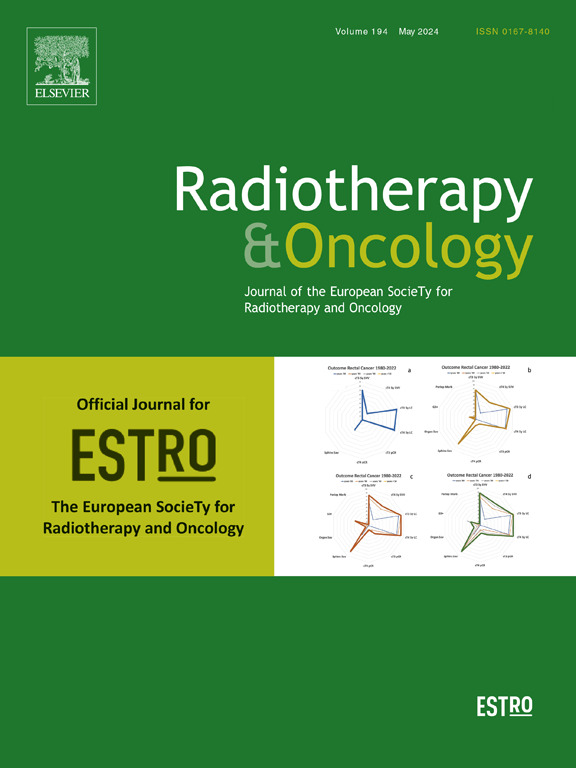PIM kinase inhibition counters resistance to radiotherapy and chemotherapy in human prostate cancer
IF 4.9
1区 医学
Q1 ONCOLOGY
引用次数: 0
Abstract
Purpose
PIM kinases are associated with treatment resistance and poor prognosis in prostate cancer through roles in DNA damage response, cellular metabolism, proliferation, and survival. We hypothesized PIM inhibition addresses treatment resistance to radiotherapy and docetaxel in prostate cancer.
Methods
PIM inhibition in prostate cancer cell lines was examined by phosphorylated H2AX and colony formations assays. In normal and castrated mice with prostate tumor xenografts, tumor growth was monitored with daily oral PIM inhibition +/- fractionated radiotherapy (RT) or docetaxel. Radiotherapy was given 30 Gy in 15 treatments, mimicking clinical conventional daily treatment over 3 weeks in a translational murine model system.
Results
PIM inhibition decreased radiotherapy-induced DNA-damage repair and decreased cell proliferation and survival. In mice, PIM inhibition increased the efficacy of both radiation and docetaxel to reduce tumor size in hormone-dependent and −independent xenografts. Xenografts showed altered gene expression changes, including downregulation of ribosomal pathways and upregulation of cardiomyocyte signaling pathways, due to PIM inhibition as analyzed by RNA-Seq. Immunostaining of multiple proteins, including COX-2 and MDM2, was altered by PIM inhibition.
Conclusions
PIM inhibition addresses treatment resistance to docetaxel and radiotherapy in multiple prostate cancer models. Our data provide a strong rationale for testing PIM inhibitors in combination with standard therapies for treatment-resistant high-risk localized or metastatic prostate cancer in clinical trials.
PIM激酶抑制对抗人类前列腺癌放疗和化疗的耐药性
目的pim激酶通过参与DNA损伤反应、细胞代谢、增殖和存活,与前列腺癌治疗耐药和预后不良相关。我们假设PIM抑制解决了前列腺癌对放疗和多西他赛的治疗耐药性。方法采用磷酸化H2AX法和菌落形成法检测spim对前列腺癌细胞的抑制作用。在正常和去势的前列腺肿瘤移植小鼠中,通过每日口服PIM抑制+/-分割放疗(RT)或多西紫杉醇监测肿瘤生长。在转译小鼠模型系统中,15次治疗中给予30 Gy的放疗,模拟临床常规每日治疗3周。结果抑制spim抑制放射治疗诱导的dna损伤修复,降低细胞增殖和存活。在小鼠实验中,PIM抑制增加了放疗和多西他赛在激素依赖型和非依赖型异种移植物中减小肿瘤大小的效果。通过RNA-Seq分析,由于PIM抑制,异种移植物表现出基因表达改变,包括核糖体通路下调和心肌细胞信号通路上调。多种蛋白的免疫染色,包括COX-2和MDM2,被PIM抑制改变。结论spim抑制可抑制多西紫杉醇和放疗对多西紫杉醇的治疗耐药。我们的数据为在临床试验中检测PIM抑制剂与标准疗法联合治疗难治性高风险局部或转移性前列腺癌提供了强有力的理论依据。
本文章由计算机程序翻译,如有差异,请以英文原文为准。
求助全文
约1分钟内获得全文
求助全文
来源期刊

Radiotherapy and Oncology
医学-核医学
CiteScore
10.30
自引率
10.50%
发文量
2445
审稿时长
45 days
期刊介绍:
Radiotherapy and Oncology publishes papers describing original research as well as review articles. It covers areas of interest relating to radiation oncology. This includes: clinical radiotherapy, combined modality treatment, translational studies, epidemiological outcomes, imaging, dosimetry, and radiation therapy planning, experimental work in radiobiology, chemobiology, hyperthermia and tumour biology, as well as data science in radiation oncology and physics aspects relevant to oncology.Papers on more general aspects of interest to the radiation oncologist including chemotherapy, surgery and immunology are also published.
 求助内容:
求助内容: 应助结果提醒方式:
应助结果提醒方式:


